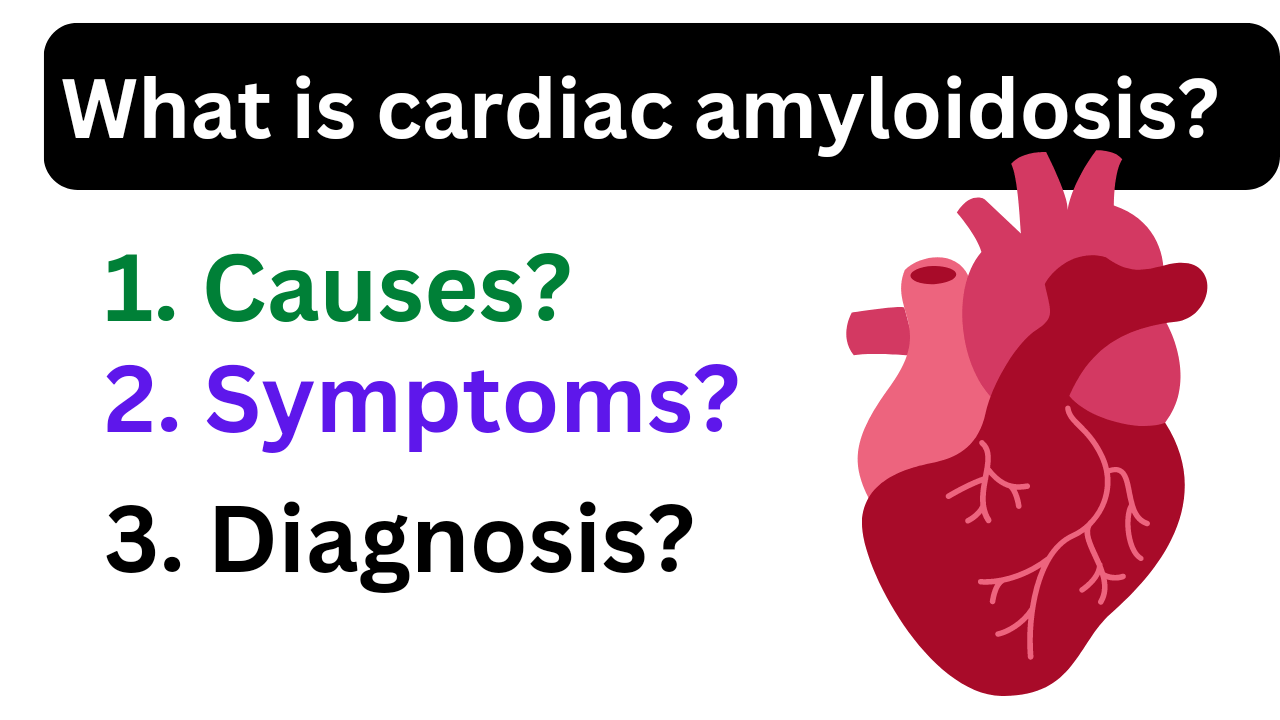Learn about “what is cardiac amyloidosis disease symptoms” .
Amyloidosis is a group of diseases characterized by the abnormal accumulation of amyloid protein in various tissues and organs of the body.
Amyloid is a type of protein that is normally found in the body, but in amyloidosis, the protein is abnormal and accumulates in various tissues, causing them to become stiff and less able to function normally.
There are several types of amyloidosis, including
- systemic amyloidosis (also known as primary amyloidosis), hereditary amyloidosis, and secondary amyloidosis.
- Systemic amyloidosis is the most common type and affects multiple organs and tissues, including the heart, liver, kidneys, and nervous system.
- Hereditary amyloidosis is an inherited condition that affects specific tissues, such as the nerves, eyes, or kidneys.
- Secondary amyloidosis is caused by underlying conditions, such as inflammation, cancer, or other diseases.
What is cardiac amyloidosis disease causes symptom?
Cardiac amyloidosis is a medical condition in which deposits of amyloid protein build up in the heart muscle and affect its ability to function normally.
Amyloid is a type of protein that is normally found in the body, but in cardiac amyloidosis, the protein is abnormal and accumulates in the heart, causing it to become stiff and less able to pump blood effectively.
This can lead to heart failure, arrhythmias, and other heart problems.
What are the causes of cardiac amyloidosis?
The causes of cardiac amyloidosis can be classified into two categories: primary and secondary.
- Primary category: It is caused due to a genetic form of the disease in which the amyloid deposits in the heart are caused by mutations in specific genes.
- There are several types of primary amyloidosis, including hereditary (familial) amyloidosis and wild-type (senile) amyloidosis.
- Secondary category: It is more common and is caused by underlying diseases such as multiple myeloma, immunoglobulin light chain (AL) amyloidosis, and systemic light chain (AA) amyloidosis.
- In these cases, the amyloid deposits in the heart are a result of the underlying disease and the deposition of the abnormal protein in the heart is a secondary event.
What are the symptoms of cardiac amyloidosis?
Following are the some possible symptoms of cardiac amyloidosis.
- Swelling: Edema, or swelling, can occur in the legs, ankles, and feet.
- Shortness of breath: This can occur during physical activity or even at rest.
- Fatigue: People with cardiac amyloidosis often feel tired and weak.
- Rapid weight gain: This can be due to fluid buildup.
- Chest pain: People with cardiac amyloidosis may experience chest pain or discomfort.
- Irregular heartbeat: This can cause palpitations or a feeling that the heart is racing.
- Dizziness or fainting: These symptoms can occur due to an irregular heartbeat or low.
- Heart failure: As the heart becomes weaker, it may not be able to pump blood effectively, leading to heart failure.
How to diagnose cardiac amyloidosis?
There are five ways to diagnose cardiac amyloidosis.
- Blood tests: Blood tests can measure levels of certain proteins that can indicate the presence of amyloid in the body.
- Electrocardiogram (ECG): This test records the electrical activity of your heart and can detect changes in your heart rhythm or other signs.
- Echocardiogram: An echocardiogram is a non-invasive test that uses sound waves to create images of your heart.
- This test can show if your heart is enlarged or if there is any fluid buildup around your heart, which can be signs of cardiac amyloidosis.
- Magnetic Resonance Imaging (MRI) or Computed Tomography (CT) scan: These tests can create detailed images of your heart and can show if there is any buildup of amyloid in the heart muscle.
- Biopsy: In some cases, your doctor may recommend a biopsy to confirm the diagnosis.
- This involves removing a small sample of heart tissue and examining it under a microscope to check for the presence of amyloid.
Here’s the video of cardiac amyloidosis causes symptom
